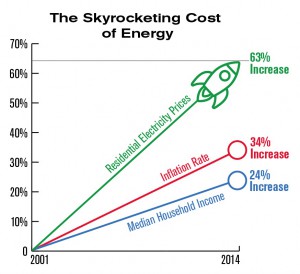The cost of electricity for Colorado residents skyrocketed 63 percent between 2001 and 2014, far outpacing median income in the state at just 24 percent over the same time period, according to Independence Institute analysis of electricity rates provided by the Energy Information Administration and census data from the U.S. Census Bureau.
Retail residential electricity rates increased from 7.47 cents per kilowatthour in 2001 to 12.18 cents per kilowatthour by 2014, a 63.1 percent hike. Coloradans’ median income, however, went up just 24.1 percent, from $49,397 to $61,303. Median income in Colorado actually declined between 2008 and 2012.

In comparison, the U.S. Bureau of Labor and Statistics’ CPI inflation calculator returned an inflation measurement of 34 percent between 2001 and 2014.


It’s clear from the data that Coloradans’ income is not keeping pace with almost continuous electricity price increases over the past 15 years, consistently outpacing the rate of inflation. Colorado’s ratepayers have had to endure two economic recessions over that period, while feeling no relief from escalating energy prices driven by onerous regulations driving energy costs ever higher.
From fuel-switching and renewable mandates to other costly regulations imposed by state and federal agencies, Colorado’s ratepayers and taxpayers alike have been subject to policies that do not consider energy affordability or reliability as a primary concern. The most vulnerable communities–elderly, minorities, and the poor–are the most sensitive to even the smallest increases in energy costs.
Not to mention the state’s many business owners, including small business owners, who face the same hikes in energy costs that could force decisions like layoffs or relocation to nearby states, where energy costs are lower. This reduces job growth and harms the state’s economy twice, with increased business costs passed on to consumers–the same ratepayers who already are paying more at the meter.
“Colorado is an outlier in front of an unfortunate nationwide trend. According to federal data, average U.S. electricity prices in 2016 are projected to be about 4.5 percent greater than 2013 levels, despite decreasing overall demand, historically low natural gas prices, and plummeting oil,” said William Yeatman, senior fellow of environmental policy and energy markets at the Competitive Enterprise Institute and author of the Independence Institute’s 2012 Cost Analysis of the New Energy Economy.
“The best explanation for this confounding upward trend in utility bills nationwide is the Obama’s administration’s war on coal. Colorado, alas, was well ahead of the curve on the war on coal, which explains much of why the state’s rate increases are presently so much greater than the nationwide average,” he continued. “Governor Ritter and PUC Chairman Ron Binz were the primary players responsible for the creation of the so-called New Energy Economy, which is perhaps better labeled the Expensive Energy Economy. Theirs was a two-part policy. First, they shuttered a number of coal-fired power plants that were already paid for and that enjoyed among the lowest fuel costs on the state’s grid. To be clear: they shut down the cheapest sources of power. Second, they replaced this cheap power with expensive power. Instead of having power plants that were paid for, they required the construction of brand new gas power plants. And they required wind, much of which was “locked in” for long periods at exorbitant rates set on the price of natural gas 8 years ago. And they required solar, a program on which all ratepayers have paid hundreds of millions of dollars to subsidize the installation of solar panels for the relatively few. Ritter and Binz are well out of office, but Coloradans now shoulder the burden of their misguided policies,” Yeatman concluded.
Yeatman’s analysis of 57 legislative items guided by Governor Ritter’s New Energy Economy push yielded $484 million in additional costs by 2012 to the state’s Xcel customers alone, or an additional $345 for every ratepayer.
But even these costs might not be all that’s in store for Colorado’s pressured electricity consumer.
“The saddest part of all is that it’s as yet uncertain whether any of Colorado’s rateshock would help stave off the worst of the Obama administration’s climate initiative, were that regulation to survive judicial review. That means that it could get much worse,” Yeatman said.







